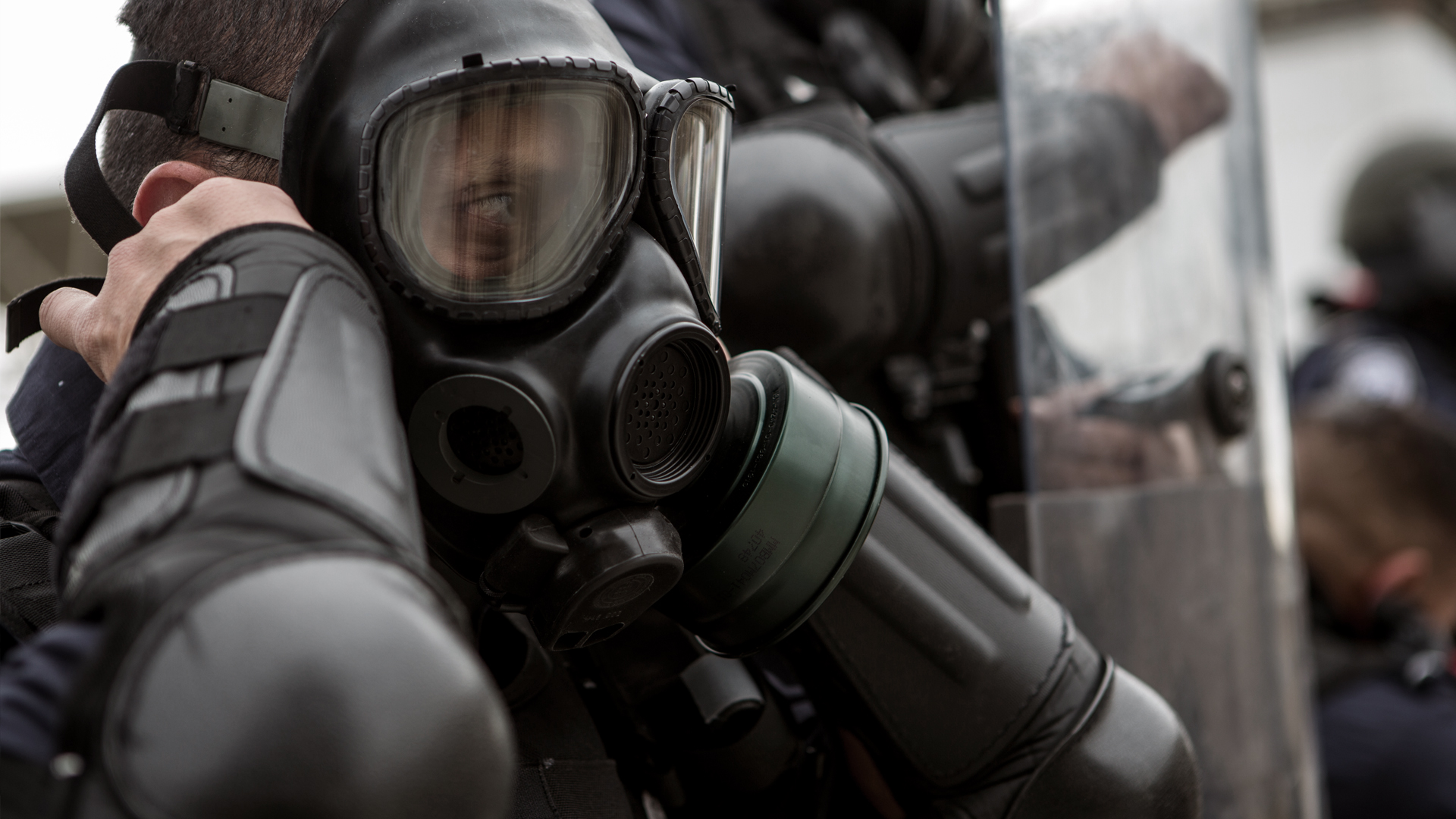Multi-Agency Task Force Prepares “Rules of Engagement” For Line 3 Protests
MINNESOTA – Unicorn Riot has uncovered documents revealing the creation of a task force stockpiling equipment and training police in preparation for Line 3 pipeline protests across the state. The documents show coordination between various law enforcement agencies from states across the region including Minnesota, Nebraska, North Dakota and South Dakota.
Documents published below for the first time show that state officials have created an incident command structure to rapidly deploy ‘Mobile Response Teams’ (or ‘MRTs’) across each Minnesota State Patrol (MSP) district in Minnesota to quickly confront any protest against the pipeline. The “Northern Lights Task Force” was created in 2018 ” to coordinate planning, resources and response to the Enbridge Pipeline 3 replacement project.”
Thus far, the Northern Lights Task Force has coordinated resources and communication between police agencies and pipeline company Enbridge, prepared responses, and facilitated civil disturbance training for hundreds of officers. Police emails, obtained by Unicorn Riot under Minnesota’s Government Data Practices Act, offer a glimpse into the structure, mission, and recent activity of the previously unknown task force.
CREATING THE TASK FORCE
As protests against the Dakota Access Pipeline (DAPL) ended in 2017,
Documents show that on July 3, 2018, MSP Lt. Paul VanVoorhis sent an email to the North Dakota Highway Patrol asking to be put in contact with their “Trooper” that presented about DAPL policing at the 2017 International Association of Chiefs of Police (IACP) Conference in Philadelphia.
According to the emails, a call was then scheduled for July 9, 2018 to allow North Dakota Highway Patrol Major Tom Iverson to speak “about the ND protest (Standing Rock), and general planning and lessons learned” at the Mobile Response Team (MRT) planning meeting in St. Cloud. According to documents, the goal of the meeting was “to connect a myriad of Mobile Response Team items, including initial pipeline response strategies.”
On July 11, 2018, MSP Officer Jeremy Geiger emailed Cass County North Dakota Sheriff Paul Laney, Highway Patrol Captain Niewind, and Fargo Police Chief David Todd to schedule a face-to-face meeting to discuss “some lessons learned, best practices” and “field force tactics” from “experts who have been there and done that.” According to the documents, that meeting took place in early September 2018.
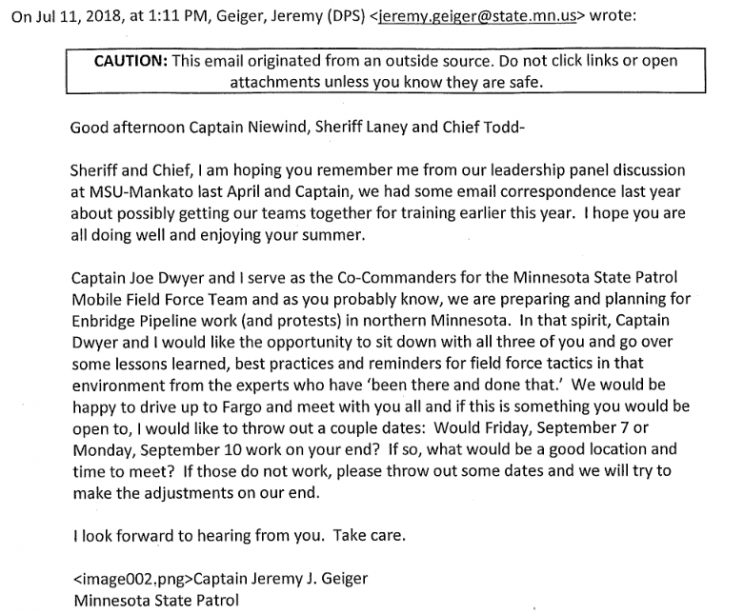
On July 27, 2018, a meeting was held between the Department of Natural Resources (DNR), Minnesota State Patrol (MSP), National Guard, the Minnesota Division of Homeland Security and Emergency Management (HSEM), Bureau of Criminal Apprehension (BCA)/Minnesota Fusion Center, the Department of Public Safety, City Attorneys, hospital staff “and other stakeholders” to discuss preparations for construction of Line 3. The meeting at the Sanford Center in Bemidji, Minnesota lasted six hours and included “breakout sessions by discipline”: law enforcement, emergency management, dispatch, intelligence, jails, and lawyers.
On July 31, 2018, Minnesota State Patrol Mobile Field Force Co-Commander Jeremy Geiger emailed Cass County Sheriff Paul Laney and Brian Niewind of the North Dakota Highway Patrol to ask if the South Dakota Highway Patrol could also attend a planning meeting scheduled in September. The officer states in the email that South Dakota law enforcement “are preparing for pipeline construction (and all that goes along with that) in 2019 across 9 counties.”
On September 10, 2018, the Northern Lights Task Force was created in Bemidji, Minnesota during a meeting at the St. Louis County Emergency Operations Center (EOC). The meeting to create the new task force “included representatives from law enforcement, jails, 9-1-1 communication centers, intelligence, emergency managers, and legal representatives.” The task force includes “all 14 counties in MN and reservations along the pipeline route.”
“The overall direction from Sheriff Turner was they wanted to see one central command post and then regional or area command posts and EOC’s.” – Dewey Johnson, Emergency Management Coordinator
NORTHERN TIER DISTRICTS
The “Northern Tier Districts” are made up of Minnesota State Patrol district 2700, 2800, 2900, 3100, 3200, and 2200. Officers from each of those districts make up the “North District Field Force” of the MSP Field Force Team. Mobile Response Teams (MRT) are deployed to disperse crowds using Mobile Field Force (MFF) tactics. (Officers deployed with an MRT are generally referred to as ‘riot police’ outside of law enforcement jargon.)
Each riot squad is equipped with batons and shields, “aerial support,” and protective equipment. “Each member has a turtle suit, helmet, batons, gas masks.” Every MRT/MFF team also includes “a member of the Chemical Agent Response Team that provides less-lethal support along with lethal cover.”

TRAINING A TASK FORCE
Line 3 is a controversial tar sands pipeline project proposed by Canadian oil giant Enbridge, and has been the target of years of protests by indigenous tribes and environmental activists.
In summer 2018, just months before the Northern Lights Task Force was formed, some agencies had already begun holding “table top” exercises at Camp Ripley, a military base also used by the Minnesota National Guard. This exercise was also attended by then-Governor Mark Dayton who “declined to comment” on the meeting, according to the StarTribune.
In July 2018, the South Central Minnesota Tactical Team and “deputies from many counties” began receiving MRT instructor training on “field force operations.” Around this time, Captain Jeremy Geiger sent an email discussing consolidation of the Rapid Response Team (RRT) and Mobile Field Force (MFF). In recent years,
The following September, beginning late in the month and lasting through early October 2018, 180 Game Wardens from the Minnesota Department of Natural Resources (DNR) received Mobile Field Force training at Camp Ripley to prepare to confront indigenous and environmental activists intent on stopping construction of Line 3. Training received by Game Wardens included “live fire” and “less lethal” exercises, including the use of chemical weapons. According to the Minnesota Department of Public Safety, the DNR can provide assistance to law enforcement operations through use of specialized equipment such as watercraft, ATVs and snowmobiles.
Another training at Camp Ripley was scheduled for early November to train new members. Around the same time, the Minnesota State Patrol MRT was scheduled to travel to FEMA’s Center for Domestic Preparedness (CDP) in Alabama for more Mobile Field Force training. Even more MFF trainings occurred in late November for Districts 2700 and 2900; according to documents these also included the use of chemical weapons. The remaining districts are likely to have held their trainings sometime in December or later.
One page within the documents describes a Special Operations “SRF CUT Team Training” on December 5, 2018, which took place at the Hennepin County Sheriffs Office (HCSO). The training consisted of a “brief review of Enbridge (Line 3) protest activity”, an “equipment inventory”, and a segment on “protest device extrication.” ‘Cut Teams’ are called into action by police command when protestors lock themselves together or to a structure, and are trained to use circular saws, hammers, and chisels to extricate individuals from lock boxes, such as “sleeping dragons.”
According to slides included in the documents, Chemical Agent Response Teams (CART) are a “high liability area” because they provide “lethal cover”, as well as deploy chemical weapons against civilians, while “everybody is watching”.

TRACKING THE RESISTANCE
The Northern Lights Task Force is also “compiling information for each of the six pipeline regions in northern Minnesota” to improve response time by the Mobile Field Force. A map included with documents shows the task force plans to “identify resources and potential flashpoints” along the new pipeline route.
In August 2018, police were already monitoring a rally in Bemidji, Minnesota, called “Line 3 Resistance Training.” In the email, police are requesting a meeting at the Law Enforcement Command (LEC) Emergency Operations Center (EOC) to discuss “preparation and response.”
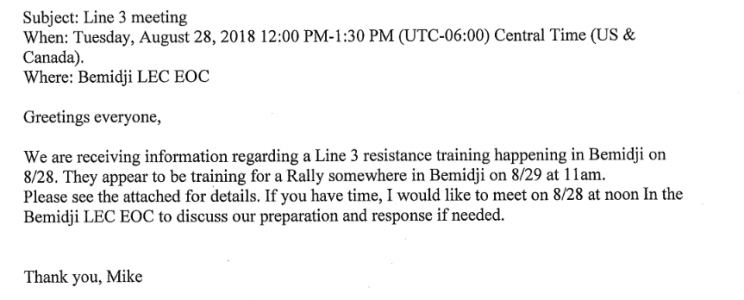
In another email, Major Dana Svendsen from the South Dakota Highway Patrol wrote Sgt. Dickenson of the Minnesota State Patrol and asked to speak “with someone about issues related to protester activity with the Enbridge pipeline.”
.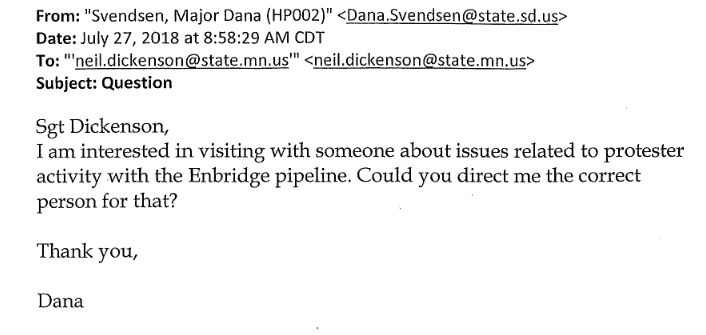
South Dakota Highway Patrol denied our public records request seeking further related emails by Major Svendsen.
Another email from August 2018 between Nebraska law enforcement and Jeremy Geiger (Co-Commander of the MSP MFF) explains various aspects of MSP intelligence gathering operations.

The emails from Minnesota law enforcement also illustrate how private actors are seeking to assist in government surveillance of pipeline protesters. One message, addressed to an officer with the Criminal Information Sharing & Analysis (CISA) unit, sports the subject line “Private Sector Partnership Meeting.” In this email, Cody Larson, a Security Intelligence Analyst working for the Mall of America, volunteered to supply background information about Line 3 pipeline protests. Larson even went so far as to offer to share files they had gathered in 2016 while working as the “Lead Tactical Analyst for the North Dakota State and Local Intelligence Center (NDSLIC/Fusion Center) during the Dakota Access Pipeline Protests.” He then went on to clarify they had worked in both North Dakota’s Tactical Operations Center (TOC) and Special Emergency Operation Center (SEOC).
As the conversation between police officials progressed, a meeting was arranged between “Line 3 Security Lead” Michael Harrington and Co-Commander Joseph Dwyer of the Minnesota State Patrol. According to the documents we received, this meeting possibly took place on Monday, October 22, 2018.

On November 19, 2018, an email shared within the a St. Paul Special Investigations Unit shows officers monitoring a “Stop Line 3” protest outside the Minnesota Public Utilities Commission.

Emails previously released to the public by Unicorn Riot in October 2018 show the Minnesota Bureau of Criminal Apprehension (BCA) Fusion Center was monitoring social media for “Line 3 Protest” activity as far back as June 2018.
TASK FORCE LOGISTICS & COMMUNICATION
A fair amount of the emails discussed the logistics of operating the task force. Topics ranged from storage of equipment, trailers and vehicles to overcoming specific obstacles such as communication and response times.
In one email, MSP officers discuss acquiring more “less lethal” munition to use during protests. Yet another email discusses ordering more “(redacted)” to have “a bit more of a stockpile on hand leading up to the suspected protests.” Another specifically mentions the “need for lethal cover” during operations. The documents also mention using a Long Range Acoustic Device (LRAD) for issuing dispersal orders.
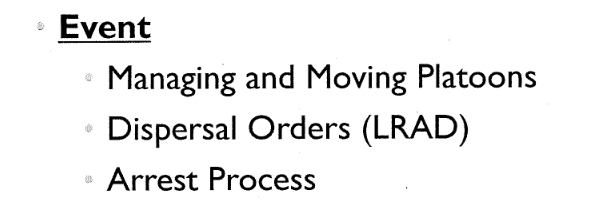

As law enforcement continues preparing for potential Line 3 protests, some resources are being put into contingency planning for the task force. One email from the DNR to Minnesota State Patrol, with “crowd control” as the subject line, discussed the “potential for pipeline protests in the Itasca State Park area” located near the proposed Line 3 construction route and just minutes away from Two Inlets, a proposed Line 3 pump station site.
THE COMING MONTHS
According to the documents, preparation by law enforcement will continue well into 2019. The DNR is scheduled to train in Mobile Field Force tactics, again, sometime in February. Meanwhile, training of “specialty teams” such as the MSP Team is scheduled for “Spring 2019/Summer 2019” at the CDP in Alabama. Cut Teams will train in “Field Force Operations, Field Force Extrication, and Field Force Command.”
A MULTI-AGENCY, MULTI-STATE RESPONSE
There has yet to be an emergency declared by the Minnesota Governor which would allow for mutual aid assistance from regional police departments to be deployed to that state, as was seen in North Dakota during NoDAPL protests. However, Minnesota law enforcement was deployed in Standing Rock under EMAC, and it is plausible that if an emergency is declared over Line 3 protests in Minnesota, North Dakota law enforcement could be called in under the same mutual assistance compact.
GROWING TENSION
The documents show that the Northern Lights Task Force intends to continue holding planning meetings and trainings throughout 2019 in anticipation of Line 3 protests. As spring draws closer, Minnesota law enforcement agencies, as well as others across the region, are actively preparing a militarized response against future protests using the same controversial playbook North Dakota used at Standing Rock.
DOWNLOAD THE ORIGINAL DOCUMENTS HERE:
Department of Public Safety Minnesota State Patrol Line 3 Emails – Part 1
Department of Public Safety Minnesota State Patrol Line 3 Emails – Part 2
Hennepin County Sheriff Line 3 Emails
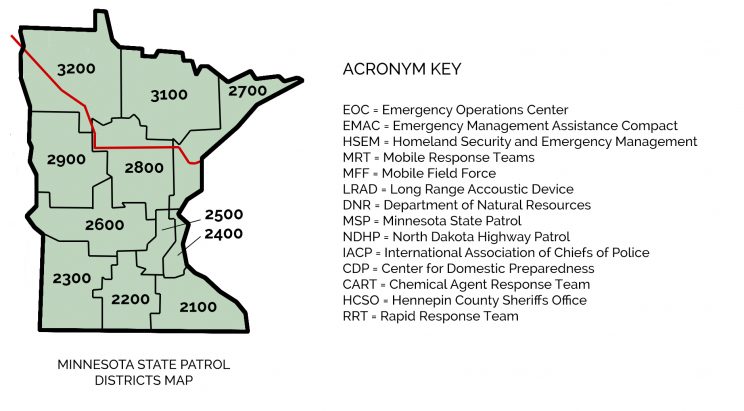
Written by Andrew Neef.
Additional reporting contributed by Chris Schiano.
Data requests and research by Andrew Neef and Chris Schiano.
Please consider a tax-deductible donation to help sustain our horizontally-organized, non-profit media organization:

How would you like to donate to Unicorn Riot?
One Time | Recurring | Cash/Check | | Grant | Wishlist
Unicorn Riot's Line 3 Oil Pipeline Coverage:
- Landing Page for all Unicorn Riot Line 3 Resistance Coverage
- Minnesota Attorney General Keith Ellison Speech Disrupted by Water Protectors - October 8, 2021
- Over 50 Line 3 Pipeline Protesters Arrested Outside MN Governor’s Residence - September 22, 2021
- Police Break Up Ceremony and Indigenous-Led #StopLine3 Occupation - August 31, 2021
- Hundreds March from Governor Residence, Urge Chase Bank Defund Line 3 - August 31, 2021
- First Trial from Treaty People Gathering Ends in Acquittal - August 23, 2021
- Line 3 Opponent Sentenced to Thirty Days in Jail - August 19, 2021
- Enbridge Spills 10,000 Gallons of Line 3 Drilling Fluid - August 16, 2021
- Line 3 Fusion Center Data Declared Secret - August 4, 2021
- Judge Orders Sheriff to Halt Harassment of Line 3 Resistance Camp - July 24, 2021
- Water Protectors Occupy Work Sites and Lock Down to Line 3 Pipeline Construction - July 1, 2021
- Hubbard County Barricades Private Property, Imprisons Water Protectors - June 28, 2021
- Indigenous-Led Blockades Occupy Line 3 Pipeline Sites - June 10, 2021
- Rising Up to the Heat: ‘Treaty People Gathering’ Resists Line 3 Pipeline - June 7, 2021
- Activists Serve Denver Wells Fargo Eviction Notice - May 3, 2021
- Appealing Line 3 Pipeline: Supply and Demand at Root of Hearing - March 23, 2021
- Caravan Disrupts Line 3 Construction Routes, Carlton County Triggers Backlash - March 13, 2021
- Treaty Rights Asserted During Creation of White Earth Camp - March 13, 2021
- 70 Water Protectors Cited, 1 Arrested During Line 3 Commemorative Rally - March 4, 2021
- Bipod and Car Blockade Jam Up Line 3 Construction - March 2, 2021
- Three Lock Down Inside Line 3 Pipeline For 6+ Hours - Feb. 21, 2021
- Lockdown to Keep it in the Ground: Line 3 Resistance - Feb. 15, 2021
- Court of Appeals Denies Motion to Stop Line 3 - Feb. 3, 2021
- Opposition to Line 3 Mounts - Jan. 29, 2021
- Resistance to Line 3: Direct Actions Aim to Stop Construction - Jan. 11, 2021
- Enbridge Line 3 Construction Blocked by Activists in Northern Minnesota - Nov. 18, 2020
- Protests After Permits for Line 3 Oil Pipeline Approved - Nov. 17, 2020
- ‘No KKKops, No Pipelines’ Banner Dropped in Minneapolis - Oct. 6, 2020
- “Divest from Climate Change!” Chase Bank Branch Protested on Opening Day - Nov. 7, 2019
- March to Protect The Sacred on Indigenous People’s Day 2019 - Oct. 14, 2019
- Hundreds Rally in Opposition to Line 3 Tar Sands Pipeline in Minnesota - Sept. 28, 2019
- Direct Action in Minnesota as Line 3 Pipeline Approval Reversed - June 3, 2019
- Multi-Agency Task Force Prepares “Rules of Engagement” For Line 3 Protests - Feb. 11, 2019
- ‘Valve Turners’ Shut Down Enbridge Oil Pipelines in Minnesota - Feb. 4, 2019
- Arts, Culture, and Hip Hop Resist Line 3 as Lawsuits Against Approval Continue - Dec. 29, 2018
- Minnesota Police Train at Military Base as Line 3 Pipeline Protests Escalate - Oct. 25, 2018
- Judge Accepts Water Protectors’ Climate Change Necessity Defense - July 18, 2018
- Line 3 Oil Pipeline Approved By Minnesota Regulators - June 28, 2018
- As Line 3 Oil Pipeline Decision Looms, Indigenous Resistance Increases - June 26, 2018
- Interfaith Community Delivers Letter of Line 3 Opposition to Minnesota Government Offices - June 4, 2018
- Minnesota Public Utilities Commission Requests Line 3 Schedule Change - Jan. 10, 2018
- Rally Against Line 3 Minnesota Pipe Yards - Dec. 11, 2017
- Resistance to Line 3 Pipeline Seeks to Save Sacred Manoomin - Oct. 9, 2017
- Direct Action Ramps Up Resistance to Line 3 - Sept. 18, 2017
Cover photo by Brendan Mullin
